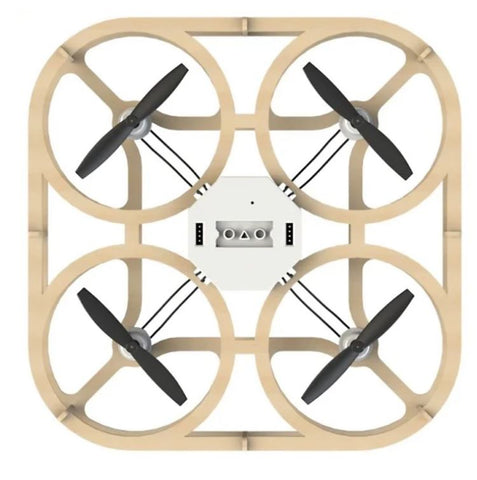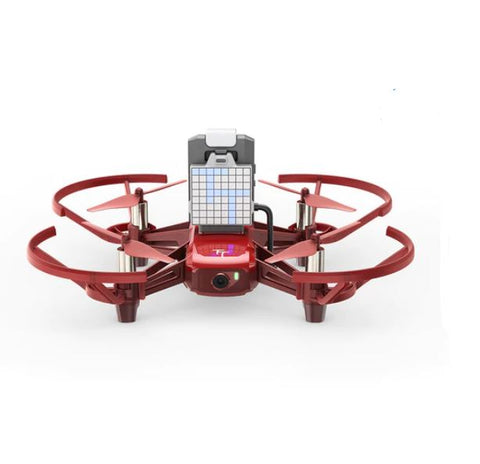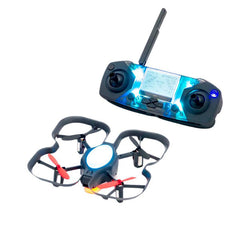Choosing the right drone is crucial, especially when you're ordering multiple for your classroom. A popular model you may have heard of is the DJI Ryze Tello EDU, so we have prepared an in-depth Tello drone review to help you make an informed decision.
We will cover the drone's key features, assess its ease of use and setup process, and explore its flying capabilities. This article will also discuss how the Tello drone can be used in education and compare it to other popular toy drones available on the market.
So buckle your seatbelt and get ready to take to the sky!
Notable features
The Tello has a compact and lightweight design with dimensions of 98 x 92.5 x 41 mm and a weight of approximately 80 grams. It's easy to transport and is suitable for both indoor and outdoor use.
Equipped with a 5MP camera capable of capturing 720p videos and high-quality still images, makes the drone ideal for casual photography and videography.
The drone has a flight time of up to 13 minutes on a single charge and a maximum control range of 100 metres, which is impressive for a drone in its class.
But what makes this DJI product truly unique is its compatibility with Python, Scratch, and Swift programming languages that allow users to create custom flight patterns and actions. This makes it a fun and educational tool for learning coding skills.
Ease of use and setup process
With the Tello app, users can control the drone via a smartphone or tablet, making it easy for beginners to operate. The app also supports VR headsets for an immersive FPV (First Person View) experience.
The Tello drone also includes features like propeller guards, auto takeoff/landing, low battery protection, and fail-safe protection, ensuring a safe flying experience for users of all skill levels.
Setting up the DJI Ryze Tello EDU drone is a straightforward process that involves a few simple steps.
- Unboxing: remove the Tello drone, battery, propeller guards, spare propellers, and any other accessories from the box. Inspect the drone and its components to ensure everything is in good condition.
- Assemble: install the propeller guards by clipping them onto the drone's arms. Ensure they are securely attached and properly aligned with the propellers.
- Charge the battery: connect the Tello's battery to the charging cable and plug it into a power source, such as a USB charger or power bank. Wait for the battery to be fully charged, which typically takes about 90 minutes. The LED indicator on the battery will turn off when charging is complete.
- Download the Tello app: visit the App Store (for iOS devices) or the Google Play Store (for Android devices) and download the official Tello app. Ensure your smartphone or tablet is compatible with the app's requirements.
- Take off: to take off, tap the "Takeoff" button on the Tello app's main screen. The drone will lift off the ground and hover at approximately 1 metre in altitude.
Performance and flying capabilities
The drone utilises a vision positioning system, along with an onboard IMU (Inertial Measurement Unit), to maintain stability and ensure precise hovering even in windy conditions.
In addition, the Tello offers various flight modes, including Throw & Go, 8D Flips, and Bounce Mode, providing users with different ways to enjoy their flight experience.
As mentioned before, this small drone has a flight time of up to 13 minutes on a single charge and a maximum control range of 100 metres, which is impressive for a drone in its class.
Finally, through a feature called Drone Swarm, it's possible to program and fly multiple Tello EDU drones at once using a single device.
Applications in education
The Tello drone can be integrated into the STEM curriculum, offering students hands-on experience with drone technology, aerodynamics, and engineering principles.
As previously mentioned, the drone is compatible with Python, Scratch, and Swift programming languages, which are designed for educational purposes. Students can learn basic coding concepts by creating custom flight patterns, actions, and even interactive games using the drone.
In addition, the Tello's built-in camera allows students to capture aerial images and videos, providing a unique perspective for creative projects.
Overall, exposure to drone technology through the Tello can help students discover potential career paths in fields such as aerospace engineering, remote sensing, robotics, or drone piloting.
Comparison to other drones
As promised, we are going to compare the DJI Tello with two other popular educational drones, so you can make a more informed decision.
We have the Airwood Cubee which comes as a DIY kit and the DJI RoboMaster TT which is similar in design to the Tello, but includes additional components such as an LED matrix, a distance sensor, and an expansion board for attaching extra hardware.
|
DJI Ryze Tello EDU |
Airwood Cubee |
DJI RoboMaster TT |
|
|
Build |
No assembly required |
Assembly required |
No assembly required |
|
Camera |
5MP 720p |
3MP 720p |
5MP 720p |
|
Controls |
Smartphone, Tablet or Controller (sold separately) |
Controller |
Smartphone, Tablet or Controller (sold separately) |
|
Flight Time |
13 min |
6-8 min |
8-13 min |
|
Range |
100 m |
50 m |
100 m |
|
Ease of Use |
Beginner |
Intermediate |
Beginner |
|
Programmability |
Python, Scratch & Swift |
Mixly |
Python & Arduino |
|
Cost |
$219.00 |
$229.95 |
$389.00 |
Find great deals on educational drones
Visit CD-Soft for great deals on the latest toy drones for education. You can find the Tello drone, the Airwood Cubee, the RoboMaster TT, and much more in our catalogue. We supply a variety of STEM-related products to help students of all ages learn modern skills such as coding.
For any help choosing the DJI Ryze Tello Drone EDU 6 Pack and best drone for your classroom, contact our friendly team on 1800 634 050 or email us at sales@cdsoft.com.au



 CoDrone EDU - $396.00 inc GST
CoDrone EDU - $396.00 inc GST






